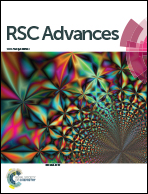Synthesis of Cu3P nanocubes and their excellent electrocatalytic efficiency for the hydrogen evolution reaction in acidic solution†
Abstract
Cu3P nanocubes are synthesized through a facile two-step strategy, which consists of a simple solution based method followed by a low-temperature phosphidation process. The Cu3P nanocubes have an average size of about 198 nm, and show a three-dimensional (3D) cubic architecture with hollow interiors and thin cubic shells. The material as an electrocatalyst for the hydrogen evolution reaction (HER) is investigated in acidic solution. It is found that the Cu3P nanocubes exhibit a low overpotential (145 mV), a small Tafel slope (70.2 mV per decade), and a large exchange current density (0.016 mA cm−2). Moreover, the Cu3P nanocubes show great electrochemical stability in acidic solution since no obvious decay in current density is observed after 1000 cycles. The excellent electrocatalytic performance can be associated with the electronic structures of Cu and P, as well as the hollow interior structure of Cu3P nanocubes, which supplies more active sites for HER. The approach used here provides an effective route for synthesizing metal phosphides with various microstructures and functions.


 Please wait while we load your content...
Please wait while we load your content...